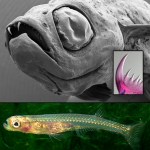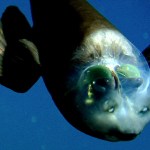fish
tags: South Pacific Islands, Solomon Islands, subsistence fishing, tuna fishing, documentary, BBC Two, streaming video
This fascinating video shows how South Pacific islanders fish for Skipjack Tuna for commercial export using hook, line and pole. Skipjack Tuna are more able to withstand the pressures of commercial fishing than other tuna species because they reach sexual maturity in one year and then spawn many times per season afterwards. Of course, they are not as commercially desirable because they are the smallest tuna species, but if humans cause the extinction of all other tuna species…
This article is reposted from the old Wordpress incarnation of Not Exactly Rocket Science.
In the Alien movies, the eponymous monster killed shipmates and marines with a fearsome set of double jaws. That may have been science fiction but science fact isn't too far off. In our planet's tropical oceans, moray eels use a ballistic set of second jaws to catch their prey.
These 'pharyngeal jaws' are housed in the eel's throat. When the main jaws close on an unlucky fish, the second set launches forward into the mouth, snags the prey with terrifying, backward-pointing teeth and drags it back into…
There are two lies you will hear from anyone who is into the sport of angling. 1) "It was THIS BIG!" and 2) "Catching fish isn't the point. It's the experience of fishing that matters."
The Mocking Bass. For four years this fish watched me cast lures and live bait from the end of the small dilapidated dock in the lagoon behind the cabin, without ever showing interest in what I had to offer. Two weeks ago I dropped a plastic worm on his head. The worm slid off and rested on the bottom. The mocking bass reoriented towards the worm and took a sniff. I jiggled the worm. And, BANG. He…
Underwater, fish make very difficult prey. When they sense sudden disturbances in the water around them, they respond within five thousandths of a second with a defensive reflex called the C-start. Their body contorts into a C-shape and with a flick of the tail, they rapidly zoom away from the potential threat. But one predator has a way of turning the fish's defence against it, persuading the fish to swim towards danger. It's the tentacled snake.
The tentacled snake (Erpeton tentaculatum) is a bizarre species, easily recognised by the pair of short "tentacles" on the front of its…
Helping out a threatened predator by culling their prey seems like a really stupid idea. But Scandinavian scientists have found that it might be the best strategy for helping some of our ailing fish stocks.
Lennart Persson and colleagues from Umeå University came up with this counterintuitive concept by running a 26-year natural experiment with the fish of Lake Takvatn, Norway. At the turn of the 20th century, the top predator in Lake Takvatn was the brown trout. Over-fishing sent its numbers crashing, and it was virtually gone by 1980.
In its place, a smaller fish - the Arctic char Â-…
In Mexico's Cueva del Azufre (the Sulphur Caves), a small fish called the shortfin molly (Poecilia mexicana) is on the way to becoming two separate species. Those that live in the dark interior of the caves are very different to their relatives that swim in the bright, surface waters. They have lighter colours and live more solitary lives. Their eyes are smaller, less sensitive and have lower levels of light-sensitive pigment. Instead, they rely instead on a hypersensitive pressure detector - the lateral line - to sense disturbances in the water.
Their differences aren't just skin deep…
My postdoc was spent looking at hybridization between humpback (Gila cypha, above) and roundtail (G. robusta) chub in the Colorado river system (see here for a publication that stemmed from that - perhaps sometime I'll post on that work). My fieldwork was at the confluence of the Colorado and Little Colorado rivers where we'd capture, measure, tag & photo the fish. Thus, I'm happy to report the following:
The humpback chub, a closely watched indicator of the Grand Canyon's ecological health, has grown steadily in number since 2001 as changing conditions on the Colorado River have…
tags: HR669, pets, exotic animals, invasive species, ornamental fish trade, aquaculture, New England Aquarium, politics
This morning, I was contacted by Scott Dowd, a biologist who specializes in studying fishes in the Amazon with the New England Aquarium. Scott sent this letter, written yesterday by Bud Ris, the President and CEO of the New England Aquarium, regarding their official position on HR 669. Scott gave permission for me to share the text of the letter here, which appears below the fold, and I also have permission to share the PDF of the letter with interested others.…
I cannot train my dog Mathman not to poop in the house, but an aquarist named Lindsay at the New England Aquarium has a Lumpfish named Blondie to do tricks (no flaming hoops yet).
Note that this is not an April Fool's joke. If it were, Blondie would also be performing Under the Sea in its entirety.
Learn the secrets of fish training from the master herself and impress stoned friends with your goldfish wrangling!
Thanks to Jeff Ives of the NEAQ for sharing.
On the 3rd of October, 2006, Nicolas Makris watched a quarter of a billion fish gather in the same place. They were Atlantic herring, one of the most abundant fishes in the ocean and one prone to gathering in massive schools. This was the first time that anyone had watched the full scope of the event, much less capture it on video.
The first signs of the amassing herring appeared around 5pm and by sunset, the gathering had begun in earnest. Once a critical level of fish was reached, the shoal expanded at a breakneck pace, suddenly growing to cover tens of kilometres within the hour. By…
tags: evolutionary biology, speciation, species flocks, molecular phylogeny, behavioral ecology, Synodontis species, squeaker catfish, cuckoo catfish, Lake Tanganyika, peer-reviewed paper
The Cuckoo Catfish, Synodontis multipunctatus [Siluriformes: Mochokidae].
This is the only fish that is a known brood parasite.
This is one of the species included in this newly-published study.
Image: orphaned.
One of the groups of fishes that I worked with as an aquarist for nearly my entire life are the synodontids, often known as "squeaker catfish" for their ability to make high-pitched sounds.…
A new kind of fish with Dracula style fangs has been discovered...in a fish tank that researchers had been keeping for a year. The fish had been living at the London Museum of Natural History for almost 12 months before scientists realized that they were a new species. They had been collected in Burma.
Which is your favorite movie in the Underworld trilogy? Ours is the latest, Rise of the Lychans.
The pointy fangs seen in the picture are actually not true teeth, but only bony protrusions coming from the fish's jaws. Furthermore researchers don't believe that the fangs are used for feeding…
tags: The Devil's Teeth: A True Story of Obsession and Survival Among America's Great White Sharks, Susan Casey, science, adventure, memoir, book review
An ocean without its unnamed monsters would be like a completely dreamless sleep.
-- John Steinbeck, The Log from the Sea of Cortez (Penguin Classics; 1995).
Unlike any of the kids I grew up with, I was absolutely fascinated by sharks. Despite their bloodthirsty reputation, I saw them as elegant and beautiful creatures, although I never appreciated them as individual personalities. But when you read journalist Susan Casey's book, The Devil's…
You're looking at the face of a new species of fish and judging by the two fearsome fangs, you'll probably understand how it got its scientific name - Danionella dracula. The teeth do look terrifying but fortunately, their owner is a tiny animal just 15 millimetres long. Ralf Britz from London's Natural History Museum discovered the fanged fish in a small stream in northern Burma, just two years ago. The more he studied them, the more he realised that they are physically extraordinary in many ways.
For a start, those are no ordinary teeth - they are actually just part of the fish's jawbone…
National Geographic has the scoop on this incredible fish that boasts a transparent, glass-like head. The two dots at the front of the fish are actually its smell organs, the eyes are under the green barrel-like structures, which can be tilted and pivoted to find food or detect predators. More pics and the full story here.
Earlier this year, I wrote about how the human obsession with size is reshaping the bodies of other species at an incredible pace. Unlike natural predators that cull the sick, weak and unfit, human fishermen prize the biggest catches and throw the smallest ones back in.
As a result, fish and other species harvested by humans are shrinking, often within a few generations, and are becoming sexually mature at an earlier stage. These changes are bad news for populations as a whole, for smaller individuals often have lower odds of survival and produce fewer offspring.
But David Conover from…
Carl explains this:
After death, brains that do not simply disappear sometimes get smaller. In this particular fish, Sibyrhynchus denisoni the brain must have gotten a lot smaller. Check out this image, in which the braincase is in red, and the brain is in yellow. (The scale bar is 5 millimeters.)
The subject is a paper in PNAS that's available to journalists but no one else so far, yet not still embargoed ... a policy I sort of like for selfish reasons but still can't figure out. This means this link to the paper won't work for a few more days. Paper is on a 3M-year-old fossilized brain,…
Last April we brought you images of a newly discovered frogfish with some unusual characteristics. Here are two videos of the Histiophryne psychedelica in action. After almost a year it has been confirmed, by the way, that this fish is indeed a new species to science.
When the fish opens its mouth for the second time, hit play on the Darkside of the Moon.
It bounces off of coral like a superball!
The green globs, inside the head, are the eyes
Imagine a fish with eyes that slide around in its head--which looks like a fighter cockpit. Meet the barreleye fish, Macropinna microstoma:
Researchers at the Monterey Bay Aquarium Research Institute recently solved the half-century-old mystery of a fish with tubular eyes and a transparent head. Ever since the "barreleye" fish Macropinna microstoma was first described in 1939, marine biologists have known that its tubular eyes are very good at collecting light. However, the eyes were believed to be fixed in place and seemed to provide only a "…
In the middle of the Pacific Ocean, Gonzalo Mucientes has discovered an invisible line in the sea that separates male mako sharks from females. The line runs from north to south with the Pitcairn Islands to its west and Easter Island to its east. On the western side, a fisherman that snags a mako will most probably have caught a male. Travel 10 degrees of longitude east and odds are they'd catch a female. This is a shark that takes segregation of the sexes to new heights.
Mucientes and colleagues from Spain, Portugal and the UK spent four months aboard a Spanish longline fishing vessel.…

